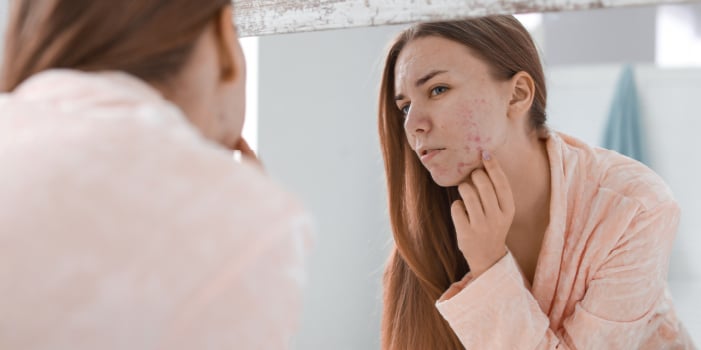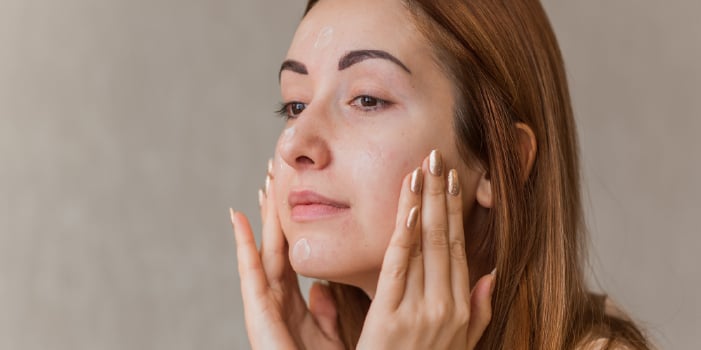You start using a new skin care product and within weeks you have acne on your face. You think, “Oh, no! I’m breaking out!” and you’re ready to toss the new product into the trash can.
But wait!
Your skin might be purging, which means the product is doing exactly what it’s supposed to do.
To know which products to keep using and which to discard, learn the difference between skin purging and breaking out.
WHAT IS SKIN PURGING?
Purging happens when you use skin care that increases cellular turnover—the process of shedding dead skin cells and creating new ones. As new skin cells develop faster, they push the dead cells and any impurities like dirt and bacteria to the surface. Essentially, the active ingredients cause you to “break out” sooner rather than later.
Unlike a regular breakout, however, purging means your skin care is getting rid of all that congestion inside your skin. Once it’s out, you’re left with a smooth, healthy, luminous complexion.
Purging is not a sign that the product is clogging your pores or causing an allergic reaction. If your skin purges after using a new product, that means you are on your way to clearer, healthier skin.
WHAT DOES SKIN PURGING LOOK LIKE?
Skin purging looks like an acne breakout, which is why it’s easy to confuse the two. It causes your skin to become red and tender and form blackheads, whiteheads, papules and pustules. Purging can also cause your skin to feel dry.
WHAT IS BREAKING OUT?
A real breakout occurs when dead skin cells, dirt, oil or bacteria clog your pores. Breakouts can also come from using the wrong products. If you use skin care with ingredients that clog your pores or irritate your skin, it can cause papules and pustules to form on your skin. These breakouts are usually red and inflamed, while purging typically appears more flesh-toned.
Unlike purging, regular breakouts do not go away over time. Continuing to use your new skin care product would only make your skin worse. So, if a new product causes you to break out, it’s time to find a replacement.

How to tell if your skin is purging or breaking out
While breaking out and purging look very similar, you can tell the difference between them by looking at these four factors:
1. Location
Purging causes your skin to “break out” where you normally see acne. If you have breakouts on your chin and forehead as usual, then your skin might just be purging.
However, if you notice pimples in abnormal places like your nose or your cheeks, it could mean your skin is breaking out.
To know for sure, stop using your new skin care product for a few days. See if you continue to have acne in those areas. If you don’t, then you know your skin is reacting to the product.
Discontinue using the product and talk to a licensed esthetician about other options that will work for you.
2. Duration
Skin purging can last 2 – 4 weeks. If the acne lasts longer than that, then it’s probably a breakout.
3. Symptoms
Examine your skin to see if it is dry or oily. If it’s dry, it’s likely purging. If it’s oily, it might be breaking out due to oil clogging your pores. If your skin is red and itchy, you might be having an allergic reaction.
4. Ingredients
Remember how purging comes from your skin producing new cells faster? That means you can check your skin care products for exfoliating ingredients, such as:
- Alpha-hydroxy acids (e.g., glycolic acid)
- Beta hydroxy acids (e.g., salicylic acid)
- Benzoyl peroxide
- Fruit enzymes
- Retinoids
You’ll often see these ingredients in acne-fighting products and chemical and physical exfoliants. You may also find them in cleansers, masques and serums.
If you start using a product that has one or more of these ingredients, you can guess your skin is purging.
However, if you see an ingredient that you are allergic to, and you start developing red itchy skin, then you know what’s causing the breakout.
Also, check for pore-clogging ingredients such as Ethylhexyl palmitate, marula oil and petroleum jelly as they may be causing your breakouts. If that’s the case, swap out your new product for a non-comedogenic alternative. Having trouble finding one? A skin care professional can help.

HOW TO MANAGE PURGING SKIN
Not all exfoliating products will purge your skin. If they do, continue to use them as recommended by your esthetician.
You may be wondering how you can avoid skin purging altogether. Sometimes it is inevitable and an essential part of improving your skin health.
However, you can reduce your symptoms by:
- Introducing your skin to one new product at a time
- Applying the new product gradually (once a week, then twice a week, then three times a week, etc.)
- Use a cleanser morning and night
- Use gentle skin care products (no scrubs)
- Use a moisturizer daily and a hydrating masque once or twice a week
- Put on sunscreen before going outside (as always)
- Add skin barrier-repairing products to your routine, such as Peptide Serum and Barrier Repair Cream with Amino Acids.
WHAT NOT TO DO WHEN PURGING
When you see your skin start to purge, you may be tempted to add on other chemicals or exfoliants to speed up the process. However, this can damage your skin as it is hypersensitive during this stage. Stick to gentle products and give your skin time to acclimate to the new product.
Whatever you do, don’t pop your pimples. It may seem like a way to get rid of them faster, but it won’t. It will only irritate your skin further and sometimes leave scars on your face. Instead, use Blemish Control No. 10 with Benzoyl Peroxide for spot treatments. It oxygenates your pores to reduce bacteria and clear your skin. Putting an ice pack on your acne is also an excellent alternative.
Avoid anything that would dry out your skin, such as too much time in the sun, washing your face with hot water and using products with fragrances, preservatives and other harsh ingredients.
CONCLUSION
The important thing to understand is that skin purging is a good thing. It’s a sign that your new skin care product is working and is a natural part of the healing process.
While waiting for skin purging to end is not fun, it’s worth the final result! As you use skin care products that exfoliate your skin and remove all the impurities it encounters, you will end up with a stunning complexion.
GlyMed Advanced Aesthetic Institute




